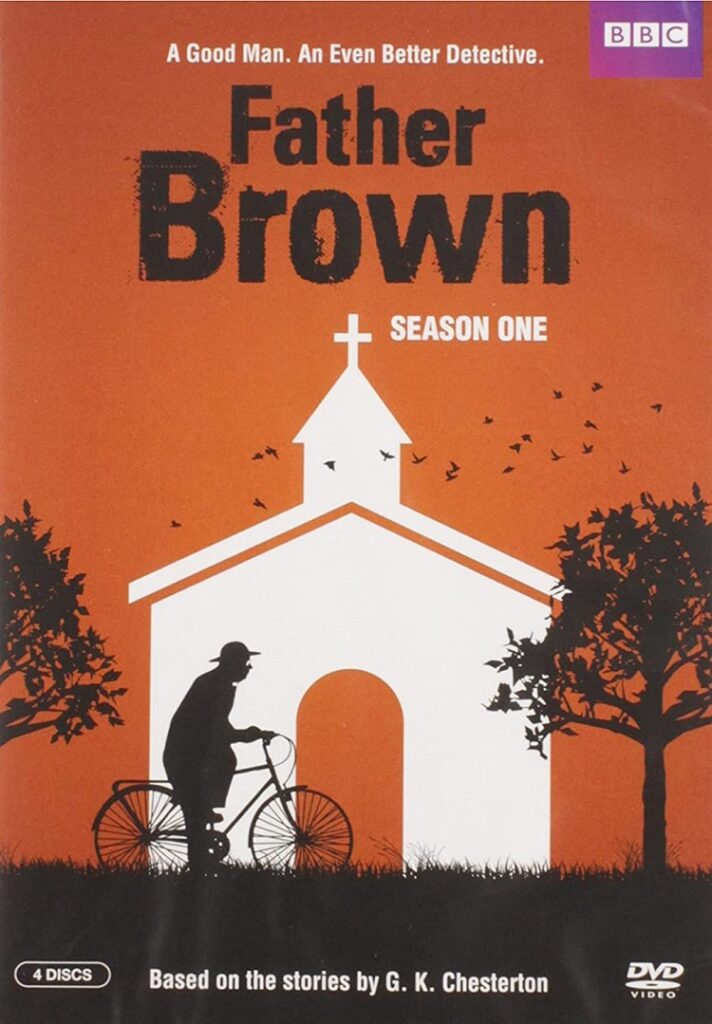
It is difficult to determine where Father Brown fails more completely: as an adaptation, or as a mystery show in its own right. Based on a character created by Catholic apologist G. K. Chesterton, the TV Father Brown‘s Catholic priest isn’t particularly Catholic. The series is set in the ’50s (all of Chesterton’s stories were contemporary and written from 1910 to 1936) but though the look of the ’50s is mostly right, the feel is not. This show is a series of mistakes, of strange and uneven characterization, and, the greatest sin of all, of outright boring mysteries.
Set in a provincial English village filled with provincial people (and, for reasons that are never clear, with a camp of Polish refugees settled nearby) Father Brown has an aesthetic and appearance that should make it a pleasant home for cozy mysteries – the style of murder mystery where the murder’s are only so grisly, where passions can run high but still, all the suspects can be placed into one room while the detective takes them through the evidence, piece by piece, until his conclusions are irrefutable. A kind of puzzle for the viewer, without too much dependence on any kind of realism.
What makes Father Brown a different kind of detective is that he is, first and foremost, a Catholic priest. He’s a small, amiable, and completely unintimidating figure (and in this series he is well played by Mark Williams, best known as the head of the Weasely clan, Arthur Weasely, in the Harry Potter movies.) He is also the cleverest person around, and can see through the most fiendishly clever plots, but he’s not a cop. He’s not an amateur sleuth. He cares about souls, not crimes.
Father Brown, the character, may believe this, but Father Brown the series does not. I can remember one episode where the villain changes his way of thinking and turns himself in. The rest are caught red-handed (usually seconds after a spiritual conversation with Father Brown) by the local constable, Valentine.
Valentine and Father Brown come from G. K. Chesterton’s stories, but the rest of the cast seems to be invented from whole cloth, and the choice of characters is baffling. There’s Lady Felicia, openly adulterous and flighty, who discovers so many of the series’ bodies it seems like it will be a running gag, but like so much in Father Brown even this mediocre idea cannot be sustained. There’s the church secretary Mrs. McCarthy, who exists seemingly to seem stupid and bigoted, and doesn’t do much else. The primary target of her unkindness is the Polish cleaning lady Susie, who seems to be in the show primarily to be pretty (does it well, too) and, in one particularly stupid episode, to join a cult of sun worshippers.
Which points to the enormous problem with the show’s stories. It seems to exist in the ’50s just so the writers can focus on “issues” of the day, in order to show how our priest was forward thinking, and how everybody else (besides victims, women and minorities) in every possible way was horrible in the ’50s. An early episode features the persecution of a communist lover, a later one has a live-in mistress and a Thalidomide baby. The stupidest might be the episode “The Devil’s Dust”, where the town nuclear committee (headed by a practically villainous Mrs. McCarthy) tries to get a girl kicked out of town because her father works at a nuclear plant, and she has some kind of illness that can’t be identified. The illness turns out to be some (very poorly explained) kind of skin mark caused by a cancer that her parent’s black handyman had, because the child (very white) was actually his and he held her as a baby. As stupid and incoherent as this precis sounds, the episode is worse. Dumber.
In every one of these “issues”, it is up to Father Brown to sniff out the ’50s prejudice that is the real crime, and he does so in the most ecumenical, least interesting (and never particularly Catholic) way. He’s constantly butting heads with Inspector Valentine, who deeply resents the Father’s intrusions despite the fact he’s always right. This is one of the most tedious, thankless recurring roles I’ve ever seen in a TV show. Hugo Speer plays Valentine, and he does an able job, but he’s just given one note to play, again and again and again. He’s there to yell at Father Brown and be wrong.
The tedium of that relationship is emblematic of the tedium of the entire series. It’s hard to see just who this show is for. Fans of G.K. Chesterton won’t recognize their priest. Fans of village mysteries will probably be irritated by the way the stories develop, and how nebulous and unformed the setting is. Fans of murder mysteries will be bored by these stories. The spirit of Chesterton has been fully exorcised from this adaptation, and with it went his sincere faith, his intelligence, and his sense of fun. This Father Brown is a pale imitation of the real thing.